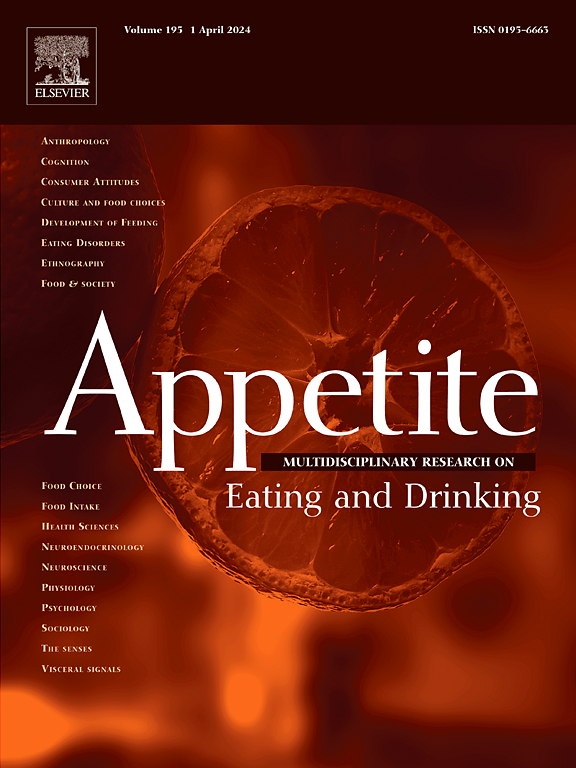中国青少年的消极情绪饮食模式:通过潜在概况分析和过渡分析进行复制和纵向扩展。
IF 3.8
2区 医学
Q1 BEHAVIORAL SCIENCES
引用次数: 0
摘要
本研究是对以往针对中国和美国大学生及普通成年人的横断面研究(Dixit 等人,2023 年;He 等人,2020 年;Xu 等人,2024 年)的纵向延伸,使用了潜在概况分析和潜在转变分析来调查 1462 名中国青少年(41% 为男孩,年龄在 11-17 岁之间)在基线和 18 个月后的消极情绪饮食模式及其稳定性。我们还探讨了消极情绪饮食模式的基线人口学预测因素,以及这些模式与 18 个月后测量的结果变量之间的关联。负性情绪化进食通过成人进食行为问卷(情绪化不进食和情绪化暴饮暴食分量表)进行测量。潜在特征分析(LPA)复制了每波评估中的四种负性情绪化进食模式:低情绪化进食(Low-EE)、情绪化暴饮暴食(EOE)、情绪化不进食(EUE)以及情绪化过度进食和进食不足(EOE-EUE)。潜在转变分析(LTA)显示,情绪化进食模式的转变概率为本文章由计算机程序翻译,如有差异,请以英文原文为准。
Negative emotional eating patterns in Chinese adolescents: A replication and longitudinal extension with latent profile and transition analyses
This study, which is a longitudinal extension of previous cross-sectional studies in Chinese and American college students and general adults (Dixit, He, Whited, Ellis, & Zickgraf, 2023; He, Chen, Wu, Niu, & Fan, 2020; Xu et al., 2024), used latent profile and latent transition analyses to investigate negative emotional eating patterns and the stability of these patterns in 1462 Chinese adolescents (41% boys, aged 11−17 years) at baseline and 18 months later. We also explored baseline demographic predictors of negative emotional eating patterns and the associations between these patterns and outcome variables measured 18 months later. Negative emotional eating was measured with the Adult Eating Behavior Questionnaire (emotional undereating and emotional overeating subscales). Latent profile analysis (LPA) replicated the four patterns of negative emotional eating in each wave of assessment: low emotional eating (Low-EE), emotional overeating (EOE), emotional undereating (EUE), and emotional over- and under-eating (EOE-EUE). Latent transition analysis (LTA) showed that the EE patterns had transition probabilities of <55% remaining in the same class across 18 months. Furthermore, relative to adolescents in the stable Low-EE group, adolescents in all other stable or unstable emotional eating groups in LTA were linked to higher eating disorder psychopathology and psychological distress measured 18 months later. Thus, emotional eating, regardless of type (i.e., EOE, EUE, and EOE-EUE) and stability (i.e., stable or unstable), may be a viable research and treatment target in improving adolescents’ eating behaviors and mental health.
求助全文
通过发布文献求助,成功后即可免费获取论文全文。
去求助
来源期刊

Appetite
医学-行为科学
CiteScore
9.10
自引率
11.10%
发文量
566
审稿时长
13.4 weeks
期刊介绍:
Appetite is an international research journal specializing in cultural, social, psychological, sensory and physiological influences on the selection and intake of foods and drinks. It covers normal and disordered eating and drinking and welcomes studies of both human and non-human animal behaviour toward food. Appetite publishes research reports, reviews and commentaries. Thematic special issues appear regularly. From time to time the journal carries abstracts from professional meetings. Submissions to Appetite are expected to be based primarily on observations directly related to the selection and intake of foods and drinks; papers that are primarily focused on topics such as nutrition or obesity will not be considered unless they specifically make a novel scientific contribution to the understanding of appetite in line with the journal's aims and scope.
 求助内容:
求助内容: 应助结果提醒方式:
应助结果提醒方式:


